"[Wodehouse] has made a world for us to live in and delight in." Evelyn Waugh
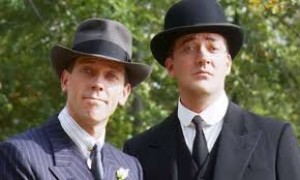
Stephen Fry and Hugh Laurie playing Jeeves and Wooster in the 1990's BBC series
P.G. Wodehouse, known to friends as 'Plum', was probably the greatest British comic writer of the twentieth century. The depictions of his colourful characters are many and varied, his books having been published in multitudinous editions and languages as well as being adapted for film, television and theatre.
The joys of collecting P.G. Wodehouse are twofold, the gratification obtained from tracking down his stories in their original format and the satisfaction of seeing the period dustwrappers lined up invitingly on your bookcase.
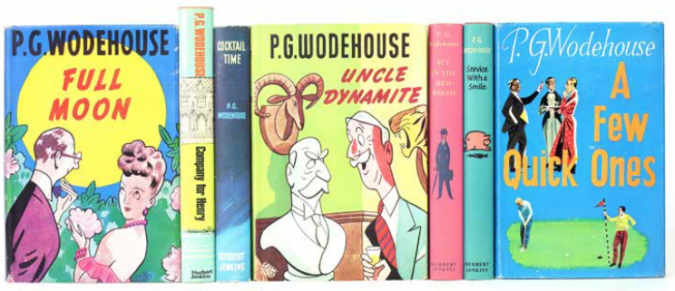
The comic tales of the exploits and mishaps of his heroes can lighten any reader’s mood and lend themselves to regular re-reading. Whether your favourite stories feature Jeeves and his hapless master, Bertie Wooster; Lord Emsworth, the inhabitants of Blandings Castle and Empress, his black Berkshire sow, or any other of the larger than life characters, the first editions (with the exception of the early school stories) can be found in the original attractive dustwrappers with artwork by many and varied artists, including such eminent ones as Rex Whistler, Osbert Lancaster and William Heath Robinson.
Undoubtedly the best known P.G Wodehouse books are the Jeeves and Wooster novels and as we love both the books and their covers we decided to share them here, hoping you will enjoy them and perhaps feel inspired to reach for your favourite volume – or even try a new one.
Jeeves and Wooster First Editions
Jeeves is introduced as the ultimate gentleman’s gentleman briefly in The Man with Two Left Feet and then more extensively in My Man Jeeves, 1919, in a collection of short stories set in New York. From the opening line "Jeeves - my man, you know - is really a most remarkable chap" the reader is immediately aware of the curious balance in the relationship between employer, a young gentleman full of joie de vivre, and his eminently sage butler.
"Jeeves ... I'm getting a check suit like that of Mr Byng's."
"Injudicious, sir... it will not become you."
Finding first editions of My Man Jeeves in the orignal dustwrapper is well nigh impossible, it is a small cheaply produced book, sold originally at 1/9, in a fragile pictorial dustwrapper. But those lucky enough to find one will find the jacket, drawn by an unnamed artist, gives us our first view of the neatly coiffured and impeccably turned out butler.
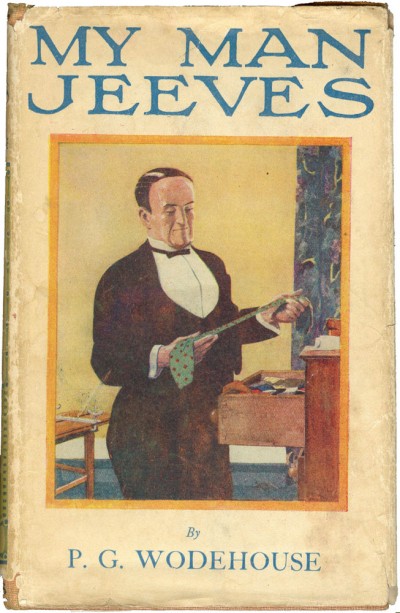
My Man Jeeves, first edition, 1919
The first full length Jeeves book The Inimitable Jeeves was published in 1923 by Hodder and Stoughton and with it began the tradition of comic artwork on the dustwrappers, in this instance the dustwrapper artist is not credited.
“What are the chances of a cobra biting Harold, Jeeves?"
"Slight, I should imagine, sir. And in such an event, knowing the boy as intimately as I do, my anxiety would be entirely for the snake.”
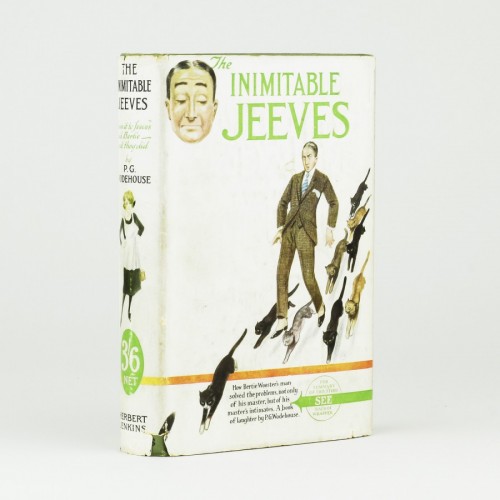
The Inimitable Jeeves, 1923
Bertie continues to be kept in check by Jeeves in Carry On Jeeves, 1925. Once again the name of dustwrapper artist is not revealed, but the front panel perfectly epitomises the butler's attitude to the follies of this employer.
“NOW, touching this business of old Jeeves – my man, you know – how do we stand? Lots of people think I’m much too dependent on him. My Aunt Agatha, in fact, has even gone so far as to call him my keeper. Well, what I say is: Why not? The man’s a genius.”
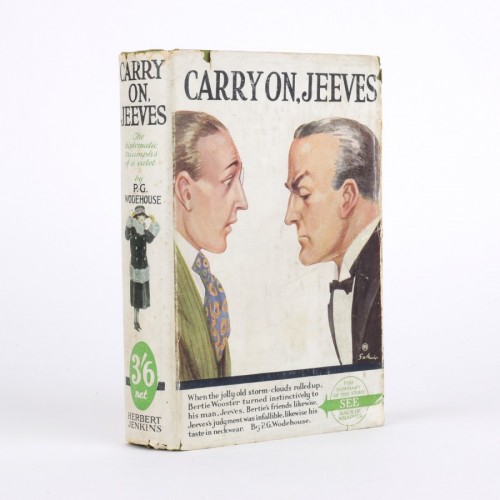
Carry On Jeeves, first edition 1925
1930 saw the publication of Very Good, Jeeves, made up of 11 short stories, which had previously been published in magazines. The colourdul cast of charaters, including Tuppy Glossop, the permantly love struck Bingo Little and the rather terrifying Aunt Agatha, are deftly handled by Jeeves. The dustjacket shows an imperious Jeeves calmy facing an assembly of well dressed artisocrats. "The handsome bindings are only the cherry on top of what is already a cake without compare" Contemporary review.
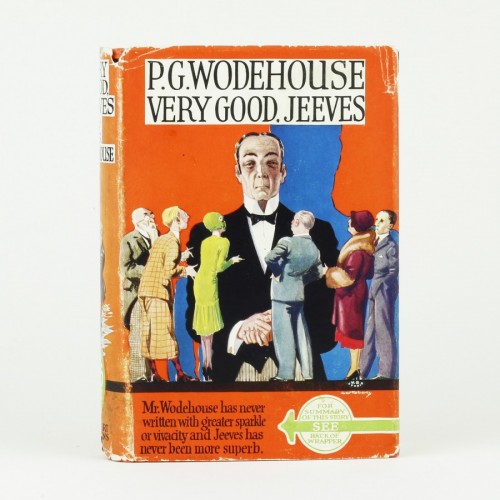
Very Good Jeeves first edition, jacket design by Roberts, 1934
The Abbey Dustjackets
The 1930's saw a slew of dustjackets for P.G. Wodehouse stories designed by Abbey, they are characterized by their portayals of larger than life round faced, rosy cheeked gentlemen often wearing animated clothing. I wonder if in 2020 they could be described as ''gammon?'
Two Jeeves books were published in 1934, Right Ho, Jeeves and Thank You Jeeves, both have jackets designed by Abbey. 'More glorious fooling' is how the publisher's advertised the 1934 publication of Thank You Jeeves, again with the dustjacket design by Abbey.
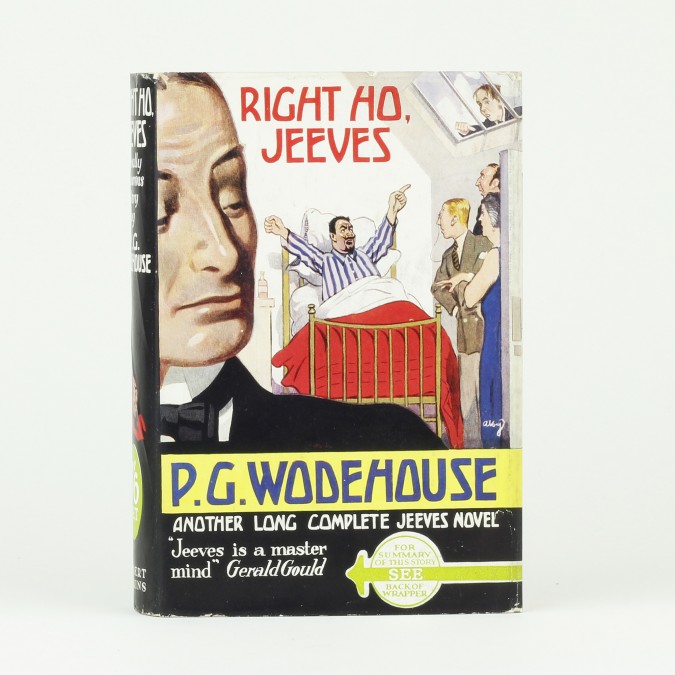
Right Ho, Jeeves first edition in the Abbey dustjacket, 1934
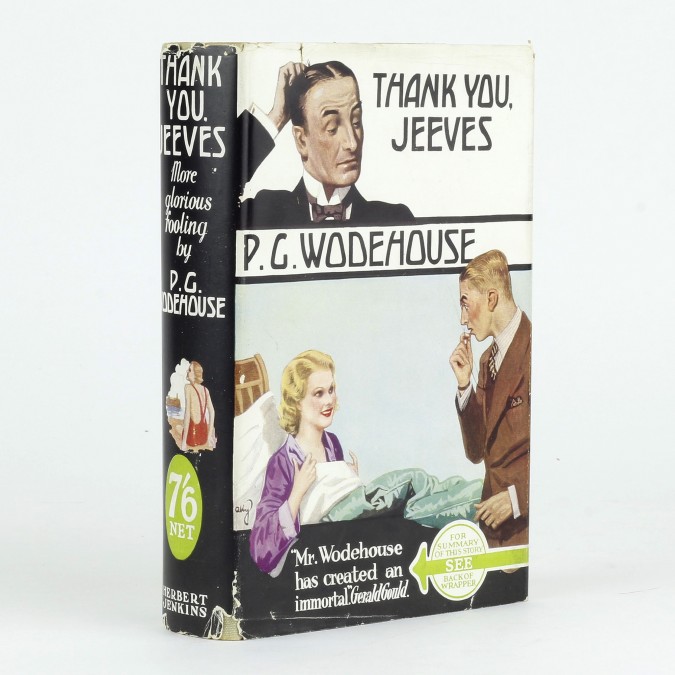
Thank You, Jeeves first edition, 1934
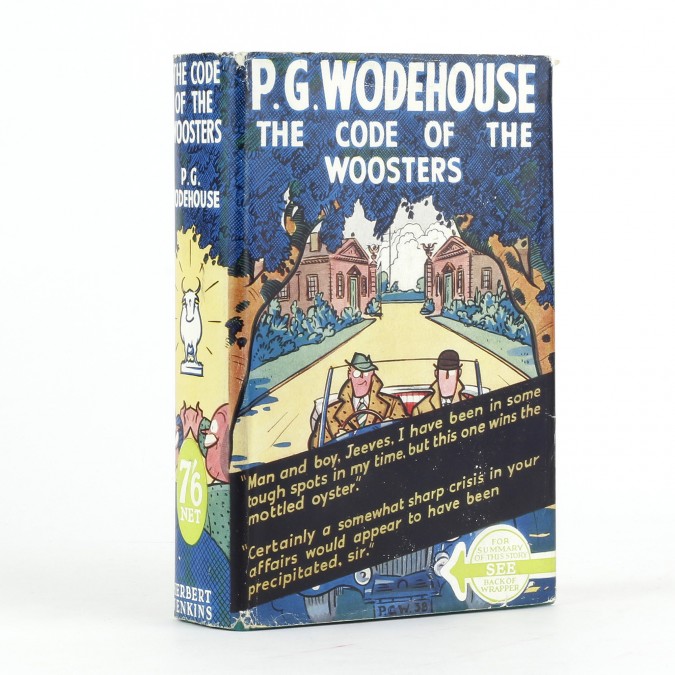
The Code of the Woosters, 1938
The Code of the Woosters has a dustwrapper designed by Ian Fenwick which shows Bertie and Jeeves arriving at Totleigh Towers in an autombile with the registartion plates "PGW 38." "Nothing but trouble can ensue when Bertie Wooster's Aunt Dahlia instructs him to steal a silver jug from Totleigh Towers, home of magistrate and hell-hound, Sir Watkyn Bassett....."
Frank Ford Jackets
The 1940's saw a golden era in the dustjacket design with the wonderfully aesthetic dustwrappers of Frank Ford.
First of the Jeeves and Wooster dustjackets designed by Ford was Joy in the Morning, 1946, followed by The Mating Season in 1949. Both jackets make use of full colour and comic design which feels ahead of its time.
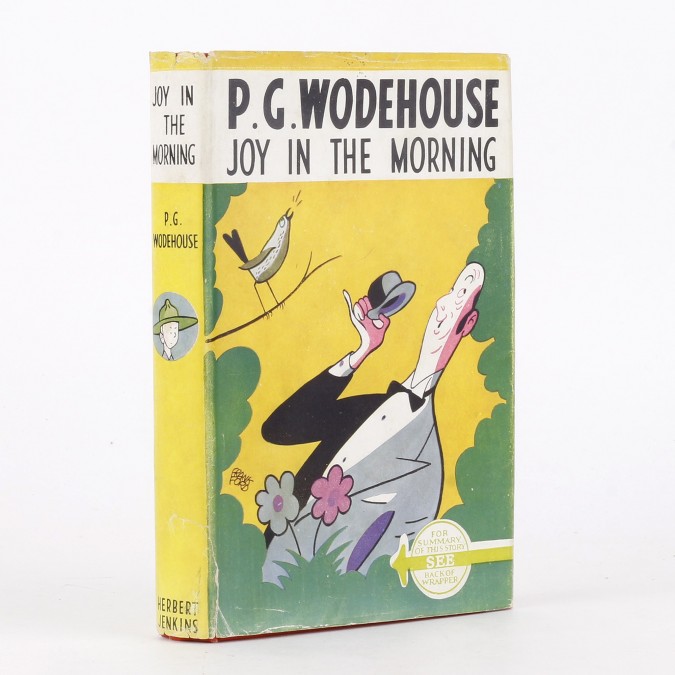
Joy in the Morning, 1946
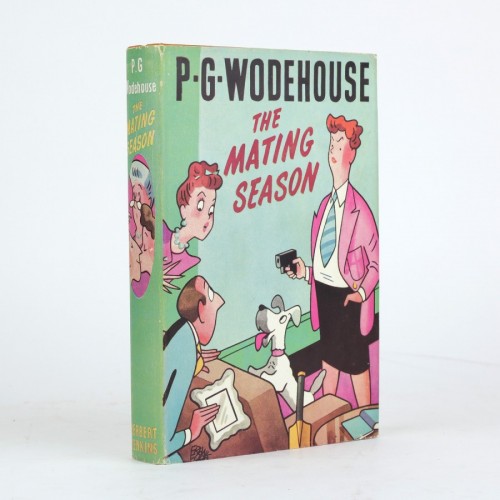
The Mating Season design by Frank Ford, 1949
For some reason Herbert Jenkins ended their association with Frank Ford in 1952 and the subsequent Jeeves dustjackets were designed by Rudolph Michael Sax [Sax], a Berlin born artist working in London. Sax's designs are less flambuoyant than those that had gone before, but present an elegant 1920's feel.
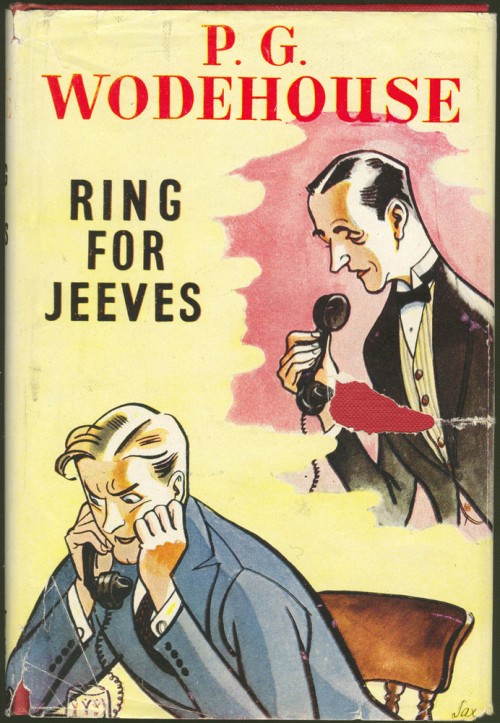
Ring for Jeeves dustjacket designed by Sax, 1953
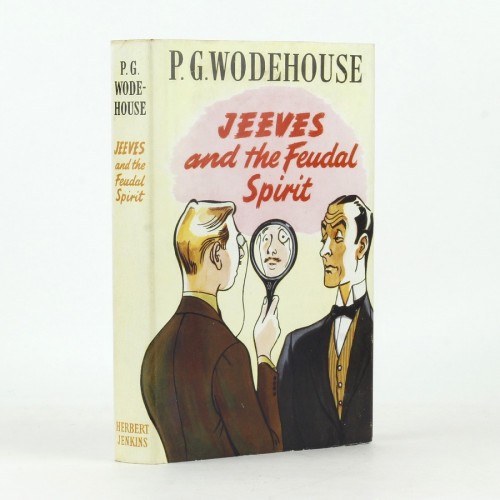
Jeeves and The Feudal Spirit, 1954
Jeeves and Wooster in the 1960's
The two Jeeves books published in the 1960's used different dustjacket artists once more, both of whom are uncredited.
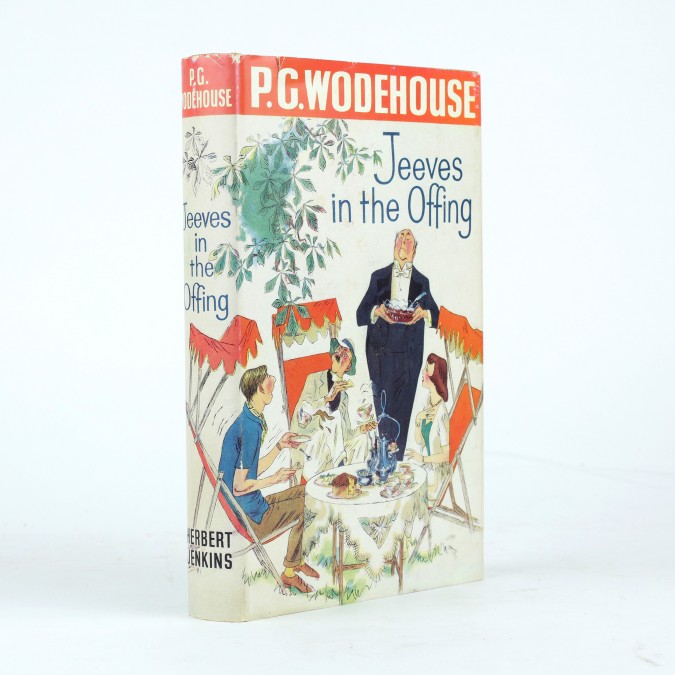
Jeeves in the Offing, 1960
Jeeves in the Offing, published in the U.S. under the title How Right You Are Jeeves, is notable to collectors for the fact that it was originally issued with the incorrect half title, reading A Few Quick Ones instead of Jeeves in the Offing. This mistake was corrected during the print run, making the first issue with incorrect half title more desirable. The jacket designed is not credited.
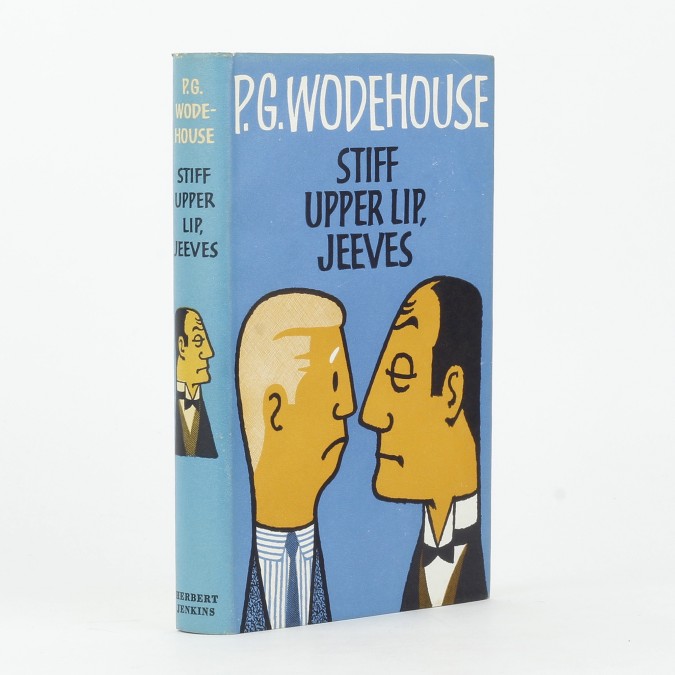
Stiff Upper Lip Jeeves, 1963
Osbert Lancaster
The final two Jeeves books, Much Obliged Jeeves, 1971, and Aunts Aren't Gentleman, 1974, both have dustwrappers designed by cartoonist and stage designer Osbert Lancaster. Lancaster was well known for his satirical cartoons which poked gentle fun at the English upper classes and this in the 1970's were well suited to accompany tales of an outmoded society.
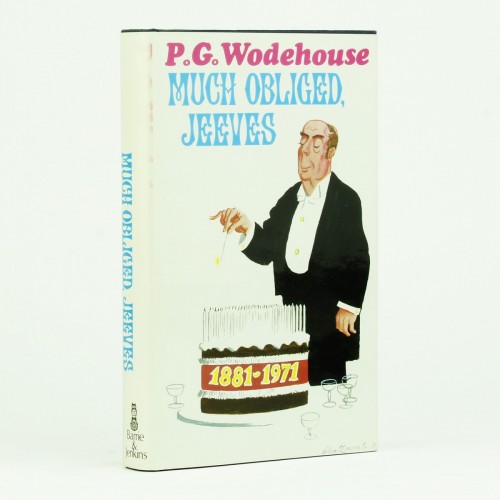
Osbert Lancaster designed dustwrapper, Much Obliged Jeeves, 1971
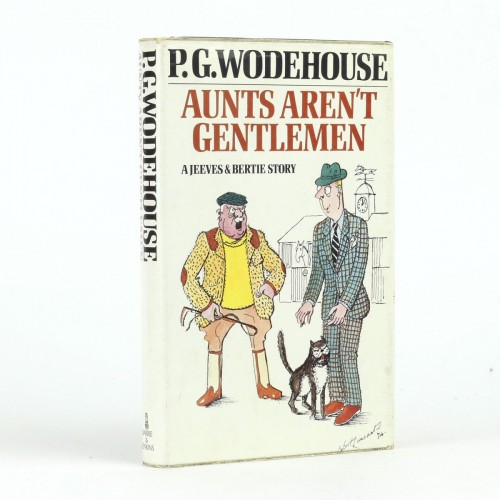
The final Jeeves and Wooster book was Aunts Aren't Gentlemen, published in 1974 and again with a dustjacket design by Osbert Lancaster.
Each decade sees a different style to the dustjacket design and yet Bertie, Jeeves and their friends don't seem to age and nor does Plum's humour become dated. His books really do furnish a room and during lockdown re-reading them has lifted our spirits no end.
Browse books by P.G. Wodehouse
Comments
Recent Posts
- The Evolution of Crime
- Tour The Bookshop On Your Screen
- The Genesis of Mr. Toad: A Short Publication History of The Wind In The Willows
- Frank Hurley's 'South'
- The "Other" Florence Harrison
- Picturing Enid Blyton
- Advent Calendar of Illustration 2020
- Depicting Jeeves and Wooster
- Evelyn Waugh Reviews Nancy Mitford
- The Envelope Booklets of T.N. Foulis
- "To Die Like English Gentlemen"
- Kay Nielsen's Fantasy World
- A Brief Look at Woodcut Illustration
- The Wealth Of Nations by Adam Smith
- What Big Stories You Have: Brothers Grimm
- Shackleton's Antarctic Career
- Inspiring Errol Le Cain's Fantasy Artwork
- Charlie & The Great Glass Elevator
- Firsts London - An Audio Tour Of Our Booth
- Jessie M. King's Poetic Art, Books & Jewellery
Blog Archive
- January 2024 (1)
- January 2023 (1)
- August 2022 (1)
- January 2022 (1)
- February 2021 (1)
- January 2021 (1)
- December 2020 (1)
- August 2020 (1)
- July 2020 (2)
- March 2020 (3)
- February 2020 (2)
- October 2019 (2)
- July 2019 (2)
- May 2019 (1)
- April 2019 (1)
- March 2019 (2)
- February 2019 (1)
- December 2018 (1)
- November 2018 (1)
- October 2018 (2)
AlexandraMcKenzie 22/Mar/2024 17:57
I'm immensely grateful for your expertise shared in this post. Your breakdown has added layers of depth to my understanding. I've explored a parallel topic on my blog and would love to intertwine our insights further. Looking forward to more enriching exchanges!